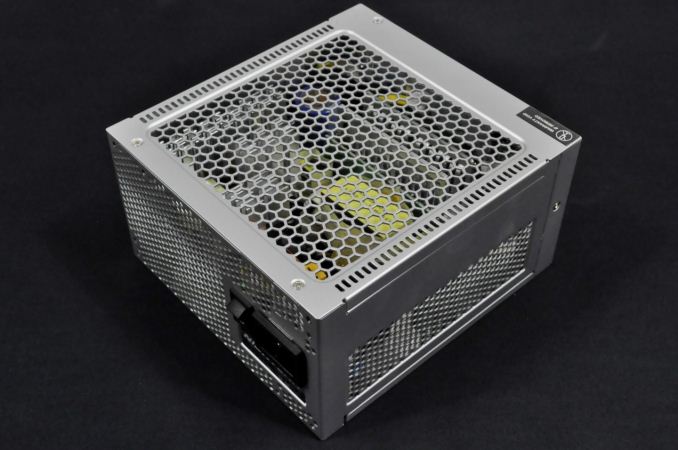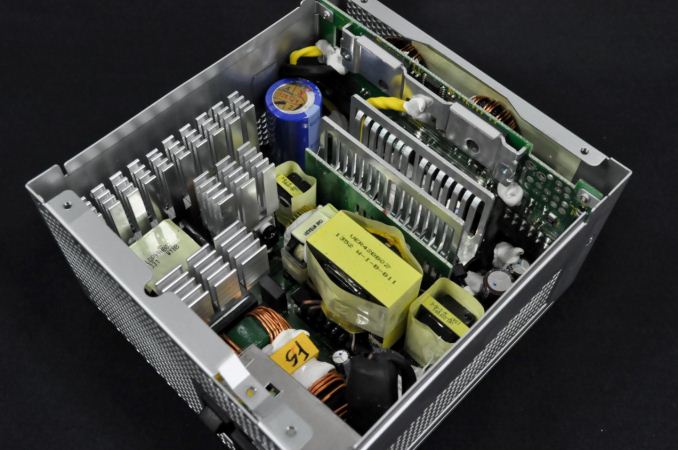SilverStone NightJar NJ520 Power Supply Review
by E. Fylladitakis on July 8, 2014 6:00 AM EST- Posted in
- Cases/Cooling/PSUs
- Seasonic
- PSUs
- Fanless
- SilverStone
External Appearance
In terms of size, the Nightjar NJ520 appears just like any other modular ATX PSU. Its silver chassis is 160mm deep, making it suitable for all ATX compliant cases. It is however noticeable that the PSU lacks a fan. The sides of the Nightjar NJ520 are perforated and, as the warning label indicates, the top side of the chassis has to be facing upwards when it is installed in a case, as the cooling scheme relies on convection via passive airflow. This will not be a problem for most modern tower cases, as they have a PSU compartment at or near their bottom; however, it will most certainly be an issue with tower cases that have the PSU compartment above the motherboard tray, or with most desktop/HTPC cases.
The front side of the chassis has even more openings for passive airflow, as well as the modular cable connectors. The connectors are black and there is a legend printed on the chassis, although they are keyed and you cannot install a cable into the wrong connector. The rear side is similar to that of any other ATX PSU, with an AC cable plug, a small switch and a metallic sticker with the series name beneath it.
Internal Design
After looking inside the Nightjar NJ520, we quickly identified that it is a Seasonic design, the one Seasonic is using for their own Platinum 520W Fanless model. There is a very strong filtering stage, partially shielded, consisting of six Y capacitors, three X capacitors and three filtering inductors. There is also a relay, which cuts off the AC supply to the unit entirely once it is turned off, to minimize losses while the system is powered off.
Despite the low output of the unit, there are two parallel rectifying bridges mounted on their own heatsink. The active APFC components, two transistors and a diode, are on the large heatsink near the edge of the PCB. The primary inversion stage consists of four switching transistors, forming a full bridge topology. The 12V conversion stage components are cooled by the U-type heatsink seen on the secondary side of the transformer. Only a 12V line is generated; the minor 3.3V and 5V lines are converted from it via DC-to-DC circuits that are on the connector's board.
A Hitachi 330μF / 420V capacitor is present for the APFC circuit. All of the secondary capacitors, electrolytic and polymer alike, are supplied by Nippon Chemi-Con. The quality of the soldering is very good, although not the best that we have seen and with a few hand-made joints. Glue is used to strengthen the unit mechanically, improving its reliability and reducing the chance of high frequency vibrations (coil whine noise).
























44 Comments
View All Comments
versesuvius - Thursday, July 10, 2014 - link
That is: "... a 1600 watt unit, which almost always uses no fan above 600 watts and you ..."versesuvius - Thursday, July 10, 2014 - link
Ooooooooooooooooooooooooooooooooooooooooooooooooops!!!!!!!That is: "a 1600 watt unit, which almost always uses no fan below 600 watts and you ..."
Dr.Neale - Friday, July 11, 2014 - link
Why not buy the genuine SeaSonic SS-520FL2 with a known seven (7) year warranty, listed on NewEgg.com for the exact same $139.99 price, and also 80+ Platinum certified, single 12V rail, fanless, 520W, etc. etc.Haravikk - Monday, July 14, 2014 - link
I have one of the Seasonic units that this is very similar to, and I have to say I've been really pleased with it; the total absence of a fan is invaluable for a quiet build.I also wanted to note, while the stickers and instructions tell you to mount this right way up, I've been running mine vertically (AC outlet aimed down) in a customised case on feet, but the airflow from the rest of the case keeps the PSU nice and cool. So with careful positioning and consideration of airflow there should be no issues, the instructions are really just for general use (pop it in, plug everything in and go).